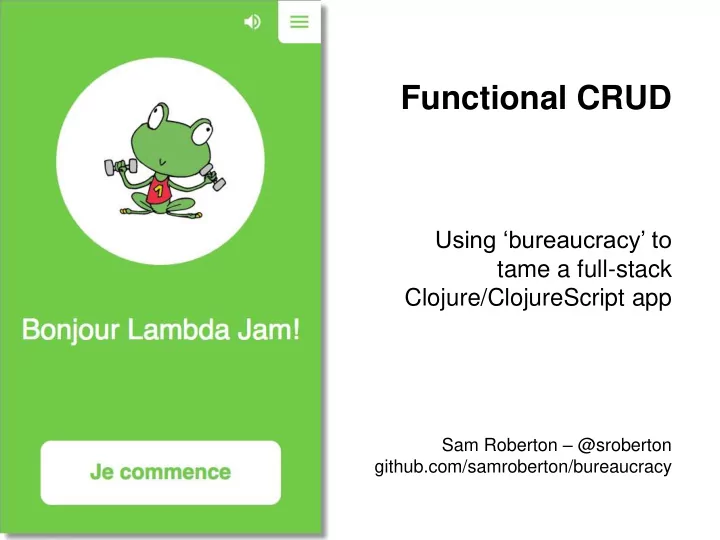

Functional CRUD Using ‘bureaucracy’ to tame a full-stack Clojure/ClojureScript app Sam Roberton – @sroberton github.com/samroberton/bureaucracy
State machines
Composeable state machines
Composeable state machines
How do we win? • portable Clojure - test code which targets the browser alongside code which targets the server • complete separation of view from state and behaviour - view is a very simple pure function of state - view effects change by dispatching events with minimal information: (dispatch :update :username “ sam ”) (dispatch :submit) - behavioural tests don't need the view
Model {:state :flashing-cards :username “ sam ” :nickname “Sam” :card {:question “Bonjour, comment ça va ?” :right- answer “ Ça va bien, merci !” :wrong- answers [“Je m'appelle Bob” “Je suis australien ” ...]} :incorrect- attempts [“Je m'appelle Bob”] :remaining-cards [{...} {...}]}
Controller (defmachine state-machine {:start :question :transitions {:question {::right-answer :correct ::wrong-answer :incorrect ::submit-answer [#{:correct :incorrect} submit-answer-next-state] ::skip-card :skipping ::finish-session :done} :correct {::next-card [#{:question :done} next-card-next-state]} :incorrect {::show-answer :show-answers ::try-again :question ::skip-card :skipping ::finish-session :done} :skipping {::next-card [#{:question :done} next-card-next-state]} :show-answers {::right-answer :correct ::submit-answer [#{:correct :incorrect} submit-answer-next-state] ::skip-card :skipping ::finish-session :done} :done {}} :transition-fn transition})
Controller (cont) (defmulti transition (fn [db event] (:id event))) (defmethod transition ::right-answer [{:keys [state-db] :as db} _] (-> db (update-in [:state-db :stats (-> (:card-and-exercise state-db) :exercise :category) (if (:incorrect-attempts state-db) :incorrect :correct)] (fnil inc 0)) (update :state-db dissoc :student-answer :incorrect-attempts :has-shown-answer?)))
View (defn [{:keys [dispatcher]} _ model] [:div [:span (:instructions model)] [:span (:question-text model)] [:button {:on-click (dispatcher :right-answer) (:right-answer-text model)] [:button {:on-click (dispatcher :wrong-answer) (first (:wrong-answer-text model))] [:button {:on-click (dispatcher :wrong-answer) (second (:wrong-answer-text model))]])
How do we win? • test behaviour (let [system (...)] (input! system :update :username “ sam ”) (input! system :update :password “pass”) (input! system :submit) (is (= :logged-in (current-state system [])))) • “test” views - call render code, but without viewing result - Devcards
What are we testing? • the whole app (def db (atom {…})) (def state- machine …) (def view- tree …) (add-watch db (view-renderer view-tree)) (defn init! [] (swap! db #(start state-machine % nil))) • only ‘ db ’ changes, in response to discrete inputs - it is a simple succession of values over time
Yay, FP is so easy! … • … but real apps aren’t pure functions of an initial DB + user inputs - real apps have AJAX calls - or local databases - or audio to play, or js/setTimeout , or … • we want to test our app’s interactions with the real world, too - we need a way to model and reason about effects
Testing the real world? • keep our state machines pure - state machine transitions are side-effect free - but they can produce an “output” data structure :outputs [{:id :submit-login :payload {:username “sam” :password “password}}] • in the app, this is an AJAX call • in tests, we have options - maybe we assert its contents - maybe we give it to the server, but in-process
Why bother? • why go to all this effort to make state machines so pure and theoretical? - easier to reason about - put the stuff we might get wrong (without noticing) where we can test it most easily
Why? It’s all good already, no? DOESN’T WORK
Test client + server in-process (with-rolled-back-db-tx [tx db-spec] (let [server (create-server tx) client (create-client {:output-handler (mock-ajax server)})] (input! client :update :username “ sam ”) ...))
What do we get? • ability to test as much or as little as we want - comprehensive system-level tests invoking a real server system with a live database - or unit-level tests of a single component with test- supplied (mocked) responses from server • fast tests - no more extended light-saber fights while Selenium pokes at a browser • succinct tests
What do we get? (bonus) • a model of our system that matches the way we think and talk about it - “user enters username” (input! system :update :username “ sam ”) - “user clicks submit” (input! system :submit) - “user is logged in” (is (= :logged-in (current-state system []))) • loose coupling of tests to implementation
What else? (more bonus?) • dispatcher tracking: know what inputs your view is capable of producing - report test coverage - random input generation / fuzzing - property-based testing? • re- use “ behaviour ” for different views - React for the web - React Native for a native phone app
Merci ! Questions ? Sam Roberton – @sroberton github.com/samroberton/bureaucracy
Recommend
More recommend